Rajasthan Board RBSE Class 12 Biology Chapter 15 Genetic Engineering
RBSE Class 12 Biology Chapter 15 Multiple Choice Questions
Question 1.
Which of the following enzyme cut DNA at a specific site?
(a) Ligase
(b) Polymerase
(c) Restriction Endonuclease
(d) All of the above
Answer:
(c) Restriction Endonuclease
![]()
Question 2.
Restriction endonuclease enzyme is found naturally in?
(a) Bacteria
(b) Virus
(c) Plants
(d) Animals
Answer:
(a) Bacteria
Question 3.
DNA Vector is?
(a) Plasmid
(b) cDNA
(c) Synthesized DNA
(d) All of the above
Answer:
(a) Plasmid
Question 4.
M13 is an example of?
(a) Plasmid
(b) Bacteriophage
(c) Cosmid
(d) All of the above
Answer:
(b) Bacteriophage
![]()
Question 5.
Which of the Blotting technique is used in the identification of DNA segments?
(a) Genomic DNA
(b) Western
(c) Southern
(d) Northern
Answer:
(c) Southern
Question 6.
Which enzyme joins free DNA ends?
(a) Restriction endonuclease
(b) Ligases
(c) Lysozyme
(d) All of the above
Answer:
(b) Ligases
Question 7.
Jumping genes are called?
(a) Phasmid
(b) Plasmid
(c) Cosmid
(d) Transposons
Answer:
(d) Transposons
![]()
Question 8.
Mullis discovered in 1989?
(a) Plasmid
(b) Polymerase chain reaction
(c) Southern Blotting technique
(d) Western Blotting technique
Answer:
(b) Polymerase chain reaction
Question 9.
C-DNA is used in the formation of?
(a) tRNA
(b) mRNA
(c) rRNA
(d) DNA
Answer:
(b) mRNA
![]()
Question 10.
Which of the following is a source of EcoRI?
(a) Bacteria
(b) Algae
(c) Plant
(d) All of the above
Answer:
(a) Bacteria
RBSE Class 12 Biology Chapter 15 Very Short Answer
Question 1.
Who is credited for developing recombinant DNA Technique (RDT)?
Answer:
Stanley Cohen, Herbert Boyer et al (1973).
Question 2.
Define recombinant DNA technology?
Answer:
Various effective measures required to incorporate changes in the DNA make up of any organism is called recombinant DNA technology.
Question 3.
What are cloning vectors?
Answer:
In recombinant DNA technology, in order to introduce the desired gene in the targeted plant/animal, a carrier is required which can carry the desired gene and can enter the targeted plant/animal and replicate it’s DNA. This carrier is called a vector. Plasmids, Bacteriophages and Cosmids are used as a vector in recombinant DNA technology.
![]()
Question 4.
What is meant by molecular probes?
Answer:
Segments of DNA or RNA with the help of which C-DNA or RNA segments of some organism can be identified are called molecular probes.
The molecular probes are of following types:
- DNA probes
- RNA probes
Question 5.
What are marker genes? Write examples.
Answer:
When the desired gene is incorporated with the vector, several unwanted products are also obtained. In order to eliminate these unwanted products and to identify the recombinant DNA in the host cell, a special type of gene is used. This produces special features in the modified/transformed cells. This gene which is incorporated in the vector DNA is called a marker gene.
Example: Kanamycin resistant gene.
Question 6.
What are reporter genes? Give examples.
Answer:
Besides marker genes, there are certain genes which produce or present some specific features in the host cell. These are called reporter genes. These genes produce a special effect on account of which the cells containing these genes look different from other cells.
Example: LUC gene found in fire-fly (“Jugnoo”) and produces bioluminescence.
Question 7.
What is the genomic library?
Answer:
Collection of the cloned segments of the entire genome of any organism is called the genomic library. A genomic library is formed by taking out complete DNA content of the haploid set of chromosomes of an organism.
Question 8.
What are Cosmids?
Answer:
Cosmids are a hybrid of plasmid and 2 (Lambda) phage. Such plasmids, in which DNA sequence of ‘Cos’ site of λ (Lambda) phage are inserted, are known as cosmids.
![]()
Question 9.
Define the restriction endonuclease enzyme.
Answer:
The enzyme which cut the DNA molecule at specific sites is called restriction endonuclease. These enzymes are just like molecular scissors, which cut DNA into the segment at specific sites.
Question 10.
Name the gels used in gel electrophoresis technique.
Answer:
- Agarose gel.
- Polyacrylamide gel.
Question 11.
Write a full form of RFLP.
Answer:
Restriction Fragment Length Polymorphism is abbreviated as RFLP.
RBSE Class 12 Biology Chapter 15 Short Answer Questions
Question 1.
What are cloning vectors? Write a brief account of various cloning vectors used in recombinant rDNA technology?
Answer:
After isolation of the desired gene(s), a vector is required which can incorporate this gene and along with it enter in the host cell & replicate it’s DNA in it. This vector is called cloning vector. Plasmid, Bacteriophages and Cosmids are main cloning vectors used in recombinant DNA technology.
Plasmids:
- These are extrachromosomal components in the bacterial cell.
- The DNA is a circular and double-stranded molecule.
- They contain an origin of replication site and can replicate independently of a bacterial chromosome.
- They have specific restriction sites where the desired gene can be incorporated.
- They have marker sites.
- The plasmid may contain 3 to one thousand genes.
Bacteriophage:
- The viruses which infect bacterially and cause lysis of bacterial cell are called bacteriophages.
Example: λ (Lambda) phage and M13 phage etc. - Bacteriophages are a better vector as compared to plasmids.
- Large DNA segments (24 Kbp) can be cloned in the bacteriophages.
- Each bacteriophage produces a plaque in the culture. Hence their identification is easy.
Cosmid:
- This is a hybrid of plasmid and λ (Lambda) phage.
- These can replicate in the host cell just like a plasmid.
- Due to the presence of ‘Cos’ site, these are packed like phage particles.
- Cosmids can be used to clone the DNA segment of up to 45 Kbp.
![]()
Question 2.
Comment on PBR 322 plasmid.
Answer:
PBR 322 plasmid is the most commonly used plasmid vector. In this plasmid, two marker sites TetR (Tetracycline resistant) and AmpR (Ampicillin resistant) are found. It contains recognition sites for 12 different restriction enzymes. Desired DNA (foreign DNA) is inserted in between TetR and AmpR gene with the help of restriction enzyme.
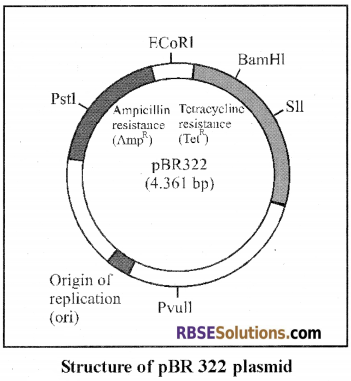
Question 3.
Write a short note on:
- Southern Blotting technique.
- DNA Fingerprinting.
- Polymerase Chain Reaction.
- Nomenclature of Restriction Enzymes.
- Features of Vectors.
Answer:
1. Southern Blotting technique:
This technique is used for the analysis of DNA segments. This was developed by E.M. Southern (1975) and hence named so. In this technique, the DNA segments are transferred on a nitrocellulose filter. These are then identified by hybridization with the DNA probes.
2. DNA Fingerprinting:
DNA Finger Printing was discovered by Alec Jeffreys and co-workers (1985). In this method DNA of a specific person is cut into small segments and is separated in the form of bands by electrophoresis. The identity of a person can be established by the specific base sequence found in the DNA of the person. This technique is used in resolving disputed paternity of any child and in detecting genetic diseases prior to the birth of a child. It is also used in the identification of criminals (Murderers and Rapists etc.)
3. Polymerase Chain Reaction (PCR):
Polymerase Chain Reaction was discovered by Mullis (1989). It is a powerful technique by which millions of copies of one DNA molecule can be obtained in a very short time without involving vectors for replication of DNA. This is performed in DNA thermal cycler. By repeating this cycle 20 – 30 times lacs of copies of DNA are obtained.
4. Nomenclature of Restriction Enzymes:
- The first alphabet of the name of enzyme represents the name of the genus from which it has been isolated. It is written in capital letters.
- The two alphabets after this represent the species of the genus. These are written in small letters.
Note: All the three letters are written in italics.
Example: E co = Escherichia coli. - The fourth alphabet (word) represents the strain of the species from which the enzyme has been isolated.
Example Eco R = R strain of E.coli. - If more than one restriction enzymes are derived from the same organism (same strain), these are indicated by Roman numbers.
Example: Eco RI, First restriction enzyme from R strain of E.coli. Eco RII, Second restriction enzyme from R strain of E.coli.
5. Features of Vectors:
- It can be inserted easily into the host cell and can be isolated easily.
- It should freely self replicate in the host cell.
- The vector must posses Restriction sites so that restriction enzyme can cut the DNA at that site so that the desired DNA fragment can be incorporated easily.
- It should have one marker gene or marker site which can help in the selection of recombinants cells.
- Transformation should be easy and perfect.
- For expression of desired foreign DNA, the vector should essentially possess components such as a promoter, operator regulating sites.
![]()
Question 4.
Explain the process of forming the Genomic Library.
Answer:
Collection of the complete DNA content of a haploid set of chromosomes (genome) of an organism is called its a genomic library. A genomic library is formed by isolating entire DNA from a cell. The genomic library is formed by the following method:
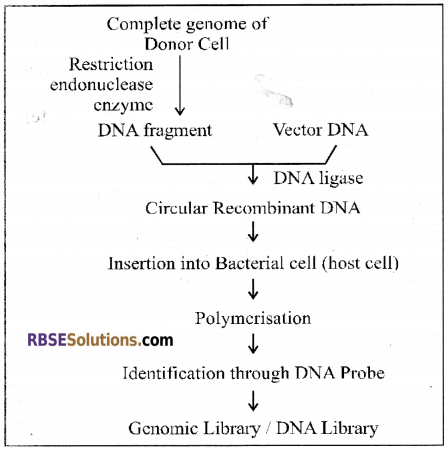
Question 5.
Write a short note on the importance of Bacteriophage as a clonal vector.
Answer:
Bacteriophages are a better vector than the plasmids due to the following reasons:
- It can clone DNA segment of relatively large size (24 kbp).
- Every bacteriophage produces one plaque area in the culture through which testing is comparatively easy.
λ (Lambda) phage is more widely used as a vector than M13 phage because λ phage is having linear and double-stranded DNA and it is phage of E.coli and large-sized foreign DNA can be easily inserted in it’s DNA.
RBSE Class 12 Biology Chapter 15 Essay Type Questions
Question 1.
Write about different stages of techniques of recombinant DNA technology.
Answer:
1. Identification and Isolation of Desired Gene:
The desired gene or DNA segment is identified and for its isolation restriction endonuclease enzyme is used. Restriction endonuclease enzyme was discovered by Werner Arber and Hamilton O. Smith (1970).
Restriction Endonuclease:
- These enzymes are just like molecular scissors, which cut DNA at specific sites.
- These enzymes are found naturally in bacteria such as E.coli, Bacillus, Streptococcus and Thermus aquatics.
- Restriction endonuclease enzymes are of three types:
- Type I Endonuclease (RI)
- Type II Endonuclease (R-II)
- Type III Endonuclease (RIII). Type II.
Note: Restriction endonuclease (RII) is most commonly used in gene cloning and restriction mapping.
Example: E.co.RI, Hind II etc.
Nomenclature of Restriction Endonuclease:
- The first alphabet of the name of the enzyme represents the genus from which it has been isolated. This is always written in capital letter.
- The two alphabets after this represent the species of that genus. These are written in small letters.
Note: All the three letters are written in italics
Example: Eco from Escherichia coli.
Hin – From Haemophilus influenza. - The fourth word represents the strain of the genus from which the enzyme has been isolated.
Example: Eco R – From R strain of E.coli. - In case more than one restriction enzymes are obtained from one organism, their number is indicated by Roman numbers.
Example: Eco RI, (First from R strain of E.coli) Eco RII etc. (Second from R. strain of E.coli) Endonuclease enzyme Eco RI recognizes specific base sequence in DNA molecule and cuts between the base G and A.
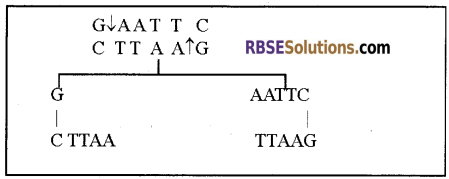
Note: When DNA segments obtained from two different sources are mixed together in the presence of DNA ligase enzyme, then both DNA segments are joined together by phospho-di-ester bonds and form a double-stranded structure.
Other Enzymes used in Genetic Engineering:
- RNA dependent DNA Polymerase – This enzyme brings about polymerisation of nucleotides of DNA strand on an RNA template.
- DNA dependent DNA Polymerase – This enzyme brings about polymerisation of nucleotides of complementary DNA strand on a DNA template.
- Ligase – This enzyme joins the ends of DNA segments on the template.
- Lysozymes – These enzymes dissolve the cell wall of bacteria so that the bacterial DNA can be easily isolated.
- Alkaline Phosphatases – This enzyme cuts the phosphate at the 5′ end of circular DNA and helps to keep it in a linear form so that the foreign DNA segment can be inserted in it. This enzyme prevents the circular nature of DNA.
2. Selection of Cloning Vectors:
The desired gene is isolated with the restriction endonuclease. This desired gene containing a segment of DNA is then incorporated in a suitable vector. This vector should be able to enter into the target host or receptor cell and should replicate it’s DNA in the host cell.
Essential features of Vector:
- It can be inserted easily into the host cell and can be isolated easily.
- It should freely replicate in the host cell.
- The vector must possess specific Restriction sites so that restriction enzyme can cut the DNA at those sites and the desired DNA fragment can be incorporated easily.
- It should have one marker gene or marker site which can help in the selection of recombinants cells.
- Transformation by it should be easy and perfect.
- For expression of desired foreign DNA, the vector should essentially possess components such as a promoter, operator regulating sites.
Note: In E.coli both natural, as well as man-made vectors, can be used.
Some important vectors used in E.coli are:
- Plasmid
- Bacteriophage
- Cosmid
1. Plasmid:
Lederber, (1952) first observed the plasmids as extrachromosomal material in Bacterial cell. It has the following important features.
-
- These are extrachromosomal (Other than chromosomal DNA) components.
- These are circular, double-stranded DNA molecules
- They contain an origin of replication (ori). Hence being able to replicate independently within the cell.
-
- These are not necessary for the growth and survival of Bacteria
.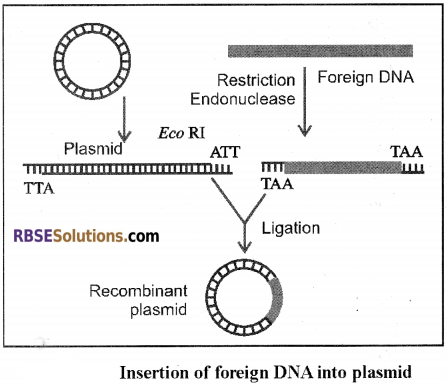
- These are not necessary for the growth and survival of Bacteria
- These contain specific restriction sites where the desired gene can be inserted.
- Marker genes or marker sites are also found.
- The plasmid may contain three to one thousand genes.
Note: The Most commonly used plasmid vector is pBR322.
In this plasmid, two marker sites TetR (Tetracycline resistant) and AmpR (Ampicillin resistant) are found. It contains recognition sites for 12 different restriction enzymes. Desired DNA (foreign DNA) is inserted in between TetR and AmpR gene with the help of restriction enzyme.
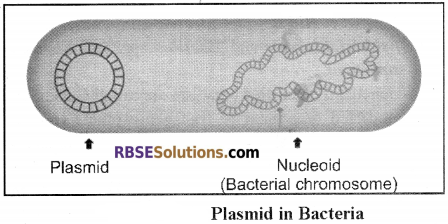
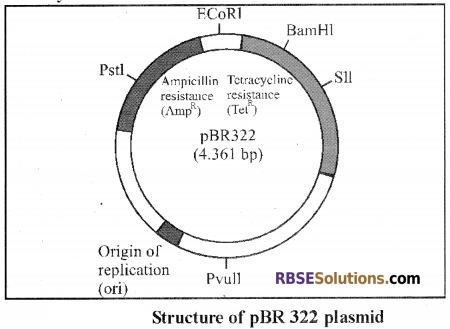
To insert the foreign DNA in the plasmid it’s DNA is made linear by use of restriction enzyme and after that in between the two ends of the DNA of plasmid, foreign DNA of 5-10 Kb is inserted or incorporated.

Note: Depending upon the condition of replication the extra chromosomal material found in the bacterial cell is called plasmid or episome. The extrachromosomal structure capable of replicating independently is called plasmid but if it replicates only when joined with the bacterial chromosome along with it, then is called as an episome.
2. Bacteriophage:
The Viruses which infect Bacteria are called Bacteriophages.
Example: λ (Lambda) and M13 etc.
Bacteriophages are a better vector than plasmids due to the following reasons:
- The DNA fragment of large size (24Kb) can be cloned in these.
- Every bacteriophage produces one plaque area through which testing is comparatively easy.
λ phage is more widely used as a vector than M13 because of the following:
- They are bacteriophage of E.coli.
- DNA is linear and double-stranded.
- Non-essential part of a phage DNA can be removed. As a result, the size of the vector molecule is reduced hence large-sized foreign DNA can be easily inserted in it.
(3) Cosmid:
- It is a hybrid of plasmid and lambda (λ) phage.
- It was first of all constructed by Barbara Horn and John Collins (1978).
- Such plasmids, in which DNA sequences of ‘Cos’ site of lambda phage DNA are inserted, are known as cosmids. Hence the cosmid possesses the features of both plasmid as well as the lambda bacteriophage.
- Cosmids replicate in the bacterial cell just like the plasmid and on account of the presence of ‘Cos’ site, these are packed like lambda phage particles.
- Cosmids can be used to clone DNA segments of up to 45 Kbp in size.
Example: CosmidPLFR-5 - There are present two Cos sites, 6 restriction endonuclease sites, the origin of replication site and tetracycline antibiotic resistance genes, in this cosmid.
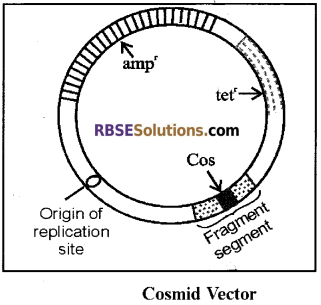
Note: Besides plasmid, bacteriophages and cosmid, there are certain other vectors also being used in genetic engineering.
- Phagemids
- Shuttle vectors
- Transposons
Transposons are also known as Jumping genes.
3. Insertion of the desired gene in the cloning vector:
For insertion of the desired gene into a cloning vector, first similar restriction sties are made in both the genes. After this, both are joined together (as both have the same restriction sites). This process is called Ligation.
In this process following enzymes are required:
- Restriction endonucleases
- Methylases
- DNA ligases
- Alkaline phosphatases
- Reverse transcriptase
- Terminal transferases
4. Multiplication of recombinant DNA in host cell:
Recombinant DNA may be inserted into the host cell by following two methods:
- Transformation
- Transduction
In this process, E.coli bacterial cell is mainly used as the host. These processes (Transformation and Transduction) have been studied earlier. The Recombinant DNA multiplies in the E.coli cells
5. Identification of the cloned gene and its transfer in other organisms:
- We are using certain genes such as antibiotic-resistant gene or LacZ gene (which produces β galactosidase) as marker genes so that if cloning sites are present in these genes and DNA is inserted in between them the genes become non-functional and called as insertional inactivation.
- On the basis of expression or non-expression of a particular gene as a marker gene, we can select recombinants from non-recombinants.
- Besides marker genes, there are certain other genes which produce specific features. These are called reporter genes which look entirely different from other cells due to special features.
Example: LUC (Luciferase) gene which is found in firefly and produces Bioluminescence.
![]()
Question 2.
Describe different blotting techniques in details.
Answer:
Blotting Technique:
In this technique, DNA segments are derived on agarose gel by electrophoresis and are then transferred and stabilised on a nitrocellulose filter. These are then identified by hybridization with DNA probes. This process is called blotting technique.
1. Southern Blotting Technique: E.M. Southern (1975) first used this method and transferred DNA segments on the nitrocellulose filter. This technique was named a Southern blotting technique. By this technical analysis of DNA, segments are done.
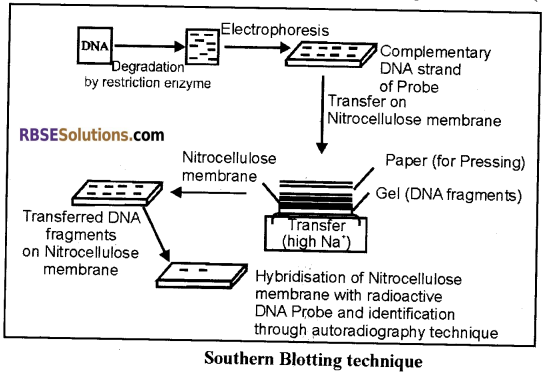
2. Northern Blotting Technique:
Alwin et al (1979) transferred RNA segments after electrophoresis on amino benzyl oximetry (OBM) membrane in place of nitrocellulose filter. This technique was named as Northern blotting technique. This technique is used for the analysis of RNA segments.
3. Western Blotting Technique:
Tobin et al. (1979) first break down proteins into polypeptides with the help of sodium-do-decyl sulphate (SDS). After separating them with the help of electrophoresis, transferred these on nitrocellulose filter or nylon membrane. These were then decoded on an X-ray plate and identified the protein. By this technical analysis of proteins is done. This is called western blotting technique.
![]()
Question 3.
Write a detailed account on plasmid as a cloning vector.
Answer:
Plasmid:
Lederber, (1952) first observed the plasmids as extrachromosomal material in Bacterial cell. It has the following important features.
- These are extrachromosomal. (Other than chromosomal DNA) components.
- These are circular, double-stranded DNA molecules.
- They contain an origin of replication (ori). Hence being able to replicate independently within the cell.
- These are not necessary for the growth and survival of Bacteria.
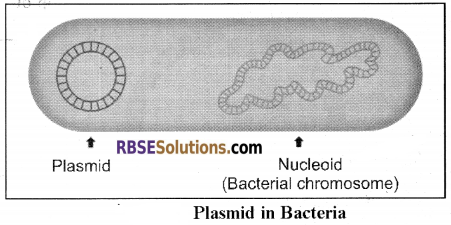
- These contain specific restriction sites where the desired gene can be inserted.
- Marker genes or marker sites are also found.
- The plasmid may contain three to one thousand genes.
Most commonly used plasmid vector is pBR322.
In this plasmid, two marker sites TetR (Tetracycline resistant) and AmpR (Ampicillin resistant) are found. It contains recognition sites for 12 different restriction enzymes. Desired DNA (foreign DNA) is inserted in between TetR and AmpR gene with the help of restriction enzyme.
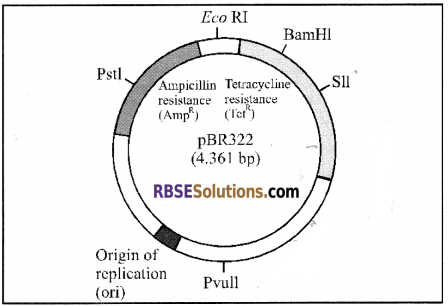
![]()
Question 4.
What do you understand by molecular probes? Explain its utility.
Answer:
Molecular Probes:
Segments of DNA or RNA with the help of which cDNA or RNA segments of any organism present in it can be identified are called molecular probes.
The molecular probes are of two types.
- DNA probes.
- RNA probes.
Importance of Probes:
- These are used to identify specific DNA segments used in the research of genetic engineering.
- Pollutants in food can be detected with the help of probes.
- These are used in the field of forensic science, in resolving disputed paternity issues and establishing the family relationship.
- These can be used to identify an improved variety of crops and hybridized seeds of crops.
Question 5.
Write an essay on the importance of genetic engineering.
Answer:
Scientist working in the field of biotechnology have succeeded in achieving results which have proved advantageous in the field of medical science, agriculture and industries. By using these techniques it has become possible to improve the variety of agricultural crops and domestic animals and also the quality of industrial products. Presently biotechnology is considered as the most important branch of biology.
Some important achievements are as follows:
- Cloning of Nitrogen fixation (Nif) gene in cereal crops.
- Cloning of Haemophilic gene.
- Cloning of Hepatitis B virus gene.
- Cloning of Human growth hormone and insulin gene.
- Cloning of penicillin G acylase gene for production of penicillin.
- Work on the Human genome project.